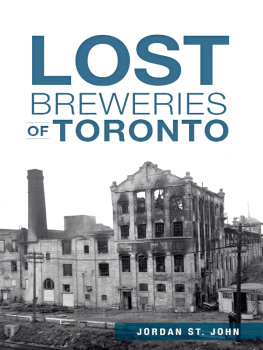TORONTO SPRAWLS
A HISTORY
With a landmass of approximately 7,000 square kilometres and a population of roughly five million, the Greater Toronto Area is Canadas largest metropolitan centre. How did a small nineteenth-century colonial capital become this sprawling urban giant, and how did government policies shape the contours of its landscape?
In Toronto Sprawls, Lawrence Solomon examines the great migration from farms to the city that occurred in the last half of the nineteenth century. During this period, a disproportionate number of single women came to Toronto while, at the same time, immigration from abroad was swelling the citys urban boundaries. Labour unions were increasingly successful in recruiting urban workers in these years. Governments responded to these perceived threats with a series of policies designed to foster order. To promote single-family dwellings conducive to the traditional family, buildings in high-density areas were razed and apartment buildings banned. To discourage returning First World War veterans from settling in cities, the government offered grants to spur rural settlement. These policies and others dispersed the citys population and promoted sprawl.
An illuminating read, Toronto Sprawls makes a convincing case that urban sprawl in Toronto was caused not by market forces, but rather by policies and programs designed to disperse Torontos urban population.
(University of Toronto Centre for Public Management Monograph Series on Public Policy and Public Administration)
LAWRENCE SOLOMON is an urban affairs columnist with the National Post, executive director of the Urban Renaissance Institute, founder and managing director of the Energy Probe Research Foundation, and a past member of the City of Toronto Planning Board.
The University of Toronto Centre for Public Management Monograph Series
Editor: Andrew Stark, University of Toronto
The University of Toronto Centre for Public Management Monograph Series is an ongoing series of books on important topical matters in public administration and public policy that will engage not only the academic community, but also policy- and opinion-makers in Canada and elsewhere.
Books are included in the series based on their originality, capacity to provoke public debate, and academic rigour.
For a list of books published in the series, see p. 121.
LAWRENCE SOLOMON
Toronto Sprawls
A History

University of Toronto Press Incorporated 2007
Toronto Buffalo London
Printed in Canada
ISBN 978-0-7727-8619-7 (cloth)
ISBN 978-0-7727-8618-0 (paper)

Printed on acid-free paper
Library and Archives Canada Cataloguing in Publication
Solomon, Lawrence, 1948
Toronto sprawls: a history / Lawrence Solomon.
(University of Toronto Centre for Public Management monograph series)
Includes index.
ISBN 978-0-7727-8618-0 (pbk.)
ISBN 978-0-7727-8619-7 (bound)
1. Cities and towns Ontario Toronto Growth History. 2. Toronto (Ont.) History. I. Title. II. Series.
HT169.C32T67 2007 307.1941609713541 C2007-900099-1
All rights reserved. No part of this publication may be reproduced, stored in a retrieval system, or transmitted in any form or by any means, electronic, mechanical, photocopying, recording, or otherwise, without the prior written permission of the publisher.
Printed for the University of Toronto Centre for Public Management by the University of Toronto Press.
Dedicated to Joan Berkeley Adams, my mother-in-law, for her
encouragement and her many recollections and reflections on the city
of her birth
Contents
WITH SATISH DHAR
WITH SATISH DHAR
Foreword
This book will provoke almost everyone. While those on the political left will welcome Solomons arguments that sprawl has neither an economic nor an environmental justification, they will be aghast that he puts the blame for sprawl on government rather than developers, the automobile lobby, or the other usual suspects.
Likewise, Solomon will provoke those on the political right, who in some corners have come to conclude that sprawl is actually a good thing. Most conservatives rebuff critiques of suburban life, which they find culturally wholesome and congenial. They will bristle at Solomons claim that the tidy suburban dream, which in their mind was the creation of market forces, could not exist without concerted government intervention. And they will bridle at Solomons claim that suburbanites, not city folk, have effectively been on the government dole.
If Solomon makes an unconventional (even unheard of) argument, he relies on the most conventional of sources the words of the political leaders who shaped Toronto and its environs. Toronto Sprawls does not construct complex arguments to make its case; it merely places readers in the Toronto of one hundred years ago and of crucial decades since, exposing them to the thinking then in vogue. It reports how politicians, responding to the great reformers of the day, argued for policies that would disperse the urban population, and it details the programs that political leaders then brought in to accomplish their goals.
Solomons many insights, which are broadly relevant to other North American urban centres, add up to one simple explanation for the cause of sprawl: governments made promises and then delivered on their promises. The upshot Toronto grew out rather than up.
Andrew Stark
Editor, University of Toronto Centre for Public Management Monograph Series
Preface
The automobile caused urban sprawl, claim studies in their hundreds. The development industrys lust for profits worsened sprawl, assert hundreds of others. People flocked to the suburbs for the house, yard, and fresh air they needed to raise their children, argue hundreds more. These factors, stated in academia and in the popular press, explain the historic migration from city to suburb that occurred in North America after the Second World War. People naturally wanted the suburban dream. The automobile allowed them to have it. The developers augmented these wants and profited. End of story.
And governments? They merely played a supporting role, by giving the public what it wanted. Governments aided in financing. Governments provided for roads and other infrastructure. And, in the process, governments also gave the developers and the automobile industry what they wanted. This basic story line, with minor twists in plot, characterizes most analyses of urban sprawl. Some might assign more weight to the role of developers and some more to the postwar craving for a suburban plot of ones own; some might applaud the rise of the suburbs for spreading home ownership and individualism and some might deplore suburbs for their waste and inefficiency. Many if not most of the studies lament that government did not stand up to the vested interests that promoted the suburbs, or that government did not do more to help cities during the flight of the population to the suburbs, and thus slow the cities decline.
This basic story, I argue, is a fable. In Toronto, and undoubtedly elsewhere, governments did not play a supporting role. They took the lead role, and also directed the show. Moreover, governments acted not to satisfy the publics desires but to frustrate them. The fable persists because of a misunderstanding of the forces at play in the creation of suburbs, and false assumptions about the postwar suburb.
Next page







